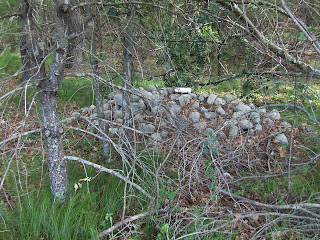"While hiking in the Sumter National Forest, I encountered several rock piles, cairns, caves, and monoliths, which a prudent person would consider to be of some archaeological value. In some cases I took pictures of them, as well as GPS waypoints. But I always left them untouched. Hiking and taking pictures in Sumter NF does not require a “permit." http://www.meteorite-times.com/bobs-findings/the-whitmire-south-carolina-bolide-of-february-13th-2012-the-search-for-meteorites-from-this-fireball-meteor-still-continues/
“A village and its surrounding territory were important elements of personal and collective identity, physical links in a chain binding a group to its past and making a locality sacred. Colonists, convinced that Indians were by nature "a shifting, wandring People," were oblivious to this, but Lawson offered a glimpse of the reasons for native attachment to a particular locale. "In our way," he wrote on leaving an Eno-Shakori town in 170I, "there stood a great Stone about the Size of a large Oven, and hollow; this the Indians took great Notice of, putting some Tobacco into the Concavity, and spitting after it. I ask'd them the Reason of their so doing, but they made me no Answer." (22) Natives throughout the interior honored similar places-graves of ancestors, monuments of stones commemorating important events-that could not be left behind without some cost (23)…”
The Indians' New World: The Catawba Experience ~ James H. Merrell http://dp.crlt.indiana.edu/jay/5th10thpics/merrell.pdf
Foot note 22: Lawson, New Voyage, ed. Lefler, 57. { http://docsouth.unc.edu/nc/lawson/lawson.html }
Foot note 23 (stone monuments): Edward Bland, "The Discovery of New Brittaine, i650," in Alexander S. Salley, ed., Narratives of Early Carolina, I650-1708 (New York, i9iI), I3-I4; William P. Cumming, ed., The Discoveries of John Lederer ... (Charlottesville, Va., I958), I2, I7, I9-20; John Banister, "Of the Natives," in Joseph Ewan and Nesta Ewan, eds.,John Banister and His Natural History of Virginia, I678-I692 (Urbana, Ill., I970), 377; William J. Hinke, trans. and ed., "Report of the Journey of Francis Louis Michel from Berne, Switzerland, to Virginia, October 2, I70i-December i, I702," Virginia Magazine of History and Biography, XXIV (i9i6), 29; Lawson, New Voyage, ed. Lefler, so; David I. Bushnell, Jr., "'The Indian Grave'-a Monacan Site in Albemarle County, Virginia," WMQ, ist Ser., XXIII (I9I4), io6- I I2. 2
Lawson Text also includes this: (Page 44: The Marble here is of different Colours, some or
other of the Rocks representing most Mixtures, but chiefly the white having
black and blue Veins in it, and some that are red. This day, we met with seven
heaps of Stones, being the Monuments of seven Indians, that were
slain in that place by the S'nnagers, or Iroquois. Our Indian Guide
added a Stone to each heap…)
(Page 213: “Then the Doctor proceeded to tell a long Tale of a
great Rattle-Snake, which, a great while ago, liv'd by a Creek in that River
(which was Neus) and that it kill'd abundance of Indians; but at last,
a bald Eagle kill'd it, and they were rid of a Serpent, that us'd to devour
whole Canoes full of Indians, at a time.)






































